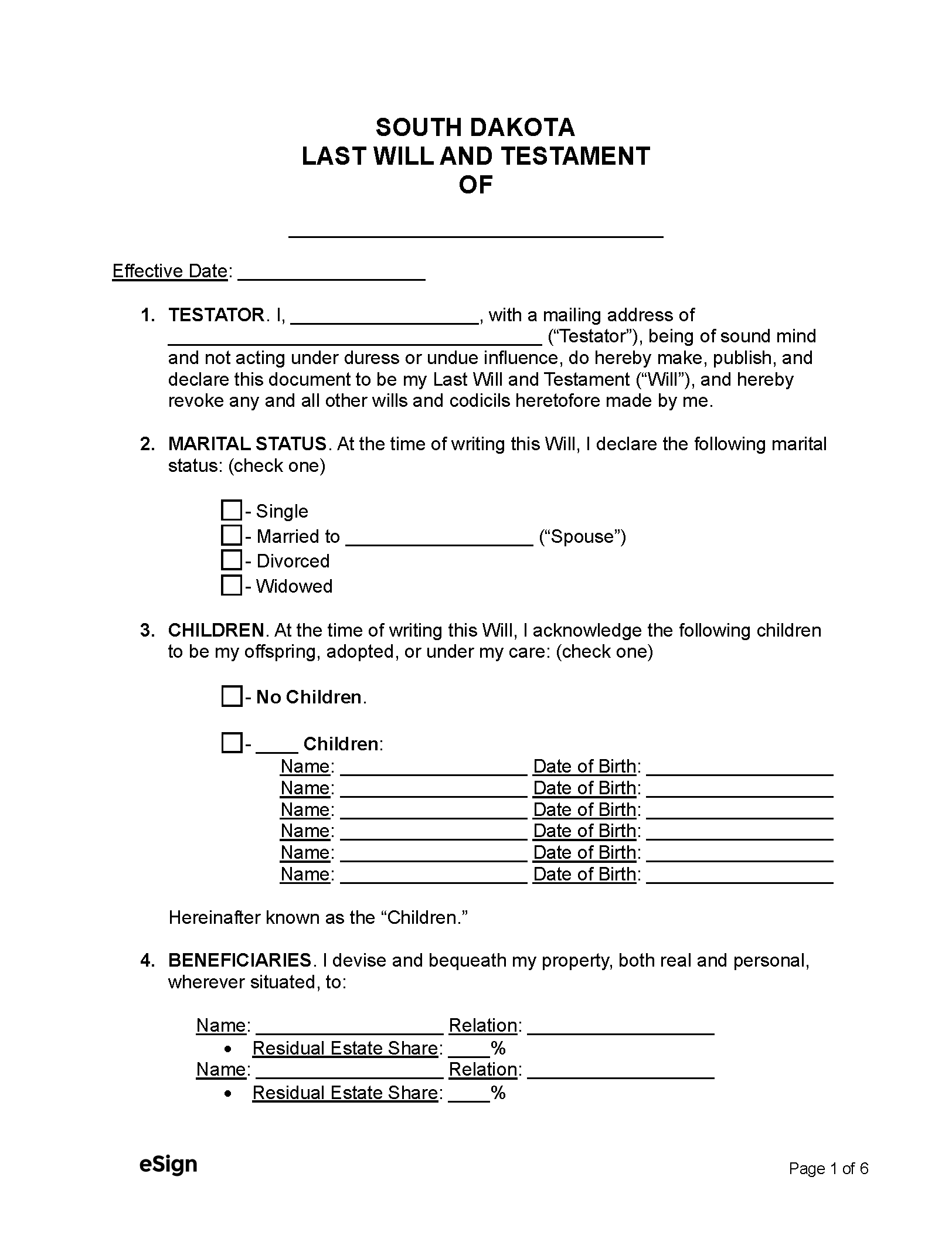State Laws
Anyone who is at least 18 years old may make a will as long as they are of sound mind.[1]
Holographic Wills – A holographic will is valid if written completely in the testator’s handwriting, including their signature.[2]
Revocation – A will may be revoked if burned, torn, or destroyed. It may also be revoked by executing a new version.[3]
Signing Requirements – Unless it is holographic, every will must contain the signatures of at least two witnesses and the testator.
Probate Process in South Dakota (8 Steps)
In most cases, the will must be probated within three years of the testator’s death.[4] This guide will cover the more straightforward informal probate process. The person filing the document will usually petition for informal probate (as opposed to formal probate), which is the process covered in the below guide.
- Demand for Notice
- File Initial Documents
- Post Bond (If Applicable)
- Notify Heirs and Beneficiaries
- Inventory and Appraisal
- Notice to Creditors
- Pay Debts and Taxes
- Distribute Assets and Close the Estate
1. Demand for Notice
When the testator dies, any interested person may file a Demand for Notice with the court requesting they be notified of any order or filing pertaining to the decedent’s estate.[5] The personal representative would then have to send notice to the demandant before any application or filing will be approved by the court.[6]
2. File Initial Documents
Beneficiaries of estates valued at $100,000 or less may use a Small Estate Affidavit to avoid probate when distributing the decedent’s assets.[7]
In most cases, probate is initiated by the personal representative named in the testator’s will. The personal representative will need to file some initial documents with the clerk of courts in the county where the decedent passed away[8]:
- Application for Informal Probate – This application includes information about the decedent, the personal representative, the devisees, the will, and a statement indicating whether a Demand for Notice has been filed.[9]
- Application for Informal Appointment of Personal Representative – This document must contain the contents of the Application for Informal Probate as well as the name, address, and priority for appointment of the person whose appointment is requested and any other individuals having the right to appointment.
- The original Last Will & Testament
If the clerk is satisfied with the documents above and at least 120 hours have elapsed since the testator’s death, they will issue a statement of informal probate, approving the documents and appointing the personal representative.[10]
3. Post Bond (If Applicable)
Unless it is waived by the court, devisees, or will, the personal representative must post bond before they are allowed to administer the estate.[11] A bond acts as an insurance policy for the estate’s heirs, devisees, and creditors, ensuring payment if the personal representative mismanages the estate. Many wills waive this requirement.
4. Notify Heirs and Beneficiaries
The personal representative must notify the decedent’s heirs and beneficiaries of their appointment within 14 days.[12] The notice should be sent by ordinary mail and include a copy of the will, as well as information about the personal representative and the court granting probate.
The South Dakota Department of Social Services must also be notified within 14 days of the appointment. They do not need to be furnished with a copy of the will. However, they must be provided with the decedent’s social security number.
5. Inventory and Appraisal
The personal representative will need to prepare an inventory of the decedent’s property, detailing the estate assets and fair market value when the decedent died.[13] This Inventory must be completed within six months of the personal representative’s appointment or nine months after the testator died, whichever is later.
A copy of the Inventory must be sent to any requesting party.
6. Notice to Creditors
Any known or reasonably ascertainable creditors must be provided a written notice that informs them that they will have to present a claim against the estate within four months of the personal representative’s appointment or 60 days of the mailing of the notice, whichever is later.[14]
The personal representative may elect to publish a Notice to Creditors in a local newspaper once a week for three consecutive weeks, notifying all creditors that they have four months to make a claim against the estate.
If no notice is published, any creditor who was not notified in writing will have three years to make a claim against the estate.[15]
7. Pay Debts and Taxes
The personal representative is responsible for settling estate debts and handling the decedent’s final tax return. A Federal Individual Income Tax Return will need to be filed for the decedent and, for large estates, a Federal Estate Tax Return.[16] If the estate earns more than $600 in gross income annually, Form 1041 must be completed.
8. Distribute Assets and Close the Estate
Once all debts have been paid, the personal representative may distribute the assets per the will’s instructions. The personal representative must create a full accounting of the estate’s distribution unless the requirement is waived by persons entitled to a copy.
If at least four months have passed after their appointment, the personal representative may file a Closing Statement with the court.[17]
The Closing Statement must declare:
- All reasonably ascertainable creditors have been paid, and the timeframe for creditor claims has expired.
- All taxes have been paid.
- The estate has been entirely administered.
- A copy of the Closing Statement and accounting have been sent to all heirs, beneficiaries, and unpaid creditors.
The personal representative’s appointment will end if a year passes without any proceedings involving them.

